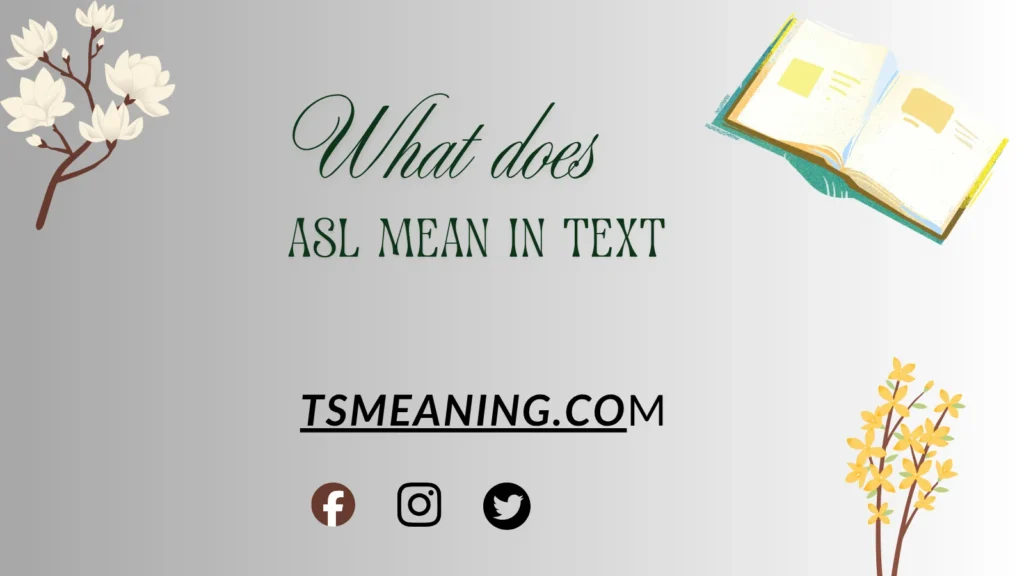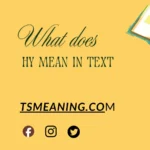Have you ever opened a text message or DM and seen someone write “ASL?” and thought… what on earth does that mean? 🤔
You’re not alone. Whether you’re chatting on Snapchat, TikTok, Discord, or dating apps, the abbreviation ASL keeps popping up everywhere. It’s one of those internet short forms that confuses many at first but makes total sense once you understand its origin and use.
In texting, ASL usually stands for “Age, Sex, Location.” It’s a quick way for someone to ask basic info about you in online chats. But here’s the twist — ASL has evolved. In 2025, it doesn’t only mean “Age, Sex, Location.” It can also mean “American Sign Language” or even be used as slang like “as hell.”
This article will break it all down — with examples, context, and the latest meanings — so you can text like a pro, sound natural, and never misinterpret ASL again. 😎📱
The Primary Meaning: ASL = Age, Sex, Location
The classic and most common meaning of ASL in texting and online chat is “Age, Sex, Location.”
This abbreviation became popular during the early days of online chatting in the late 1990s and early 2000s — especially on platforms like AOL Messenger, Yahoo Chat Rooms, and MSN.
It was a simple, fast way to get to know someone new online without long introductions.
Example conversation:
- 👤 User A: “Hey there!”
- 👤 User B: “Hey! asl?”
- 👤 User A: “22/F/California 😄”
Here, “22/F/California” means 22 years old, Female, from California.
It’s short, clear, and helped online users break the ice.
Why People Used ASL in Chats
Back when online communication was new, there was no profile info, photos, or bios. People met strangers in chat rooms and had no idea who they were talking to. So, typing “ASL?” was the easiest way to ask:
- How old are you?
- Are you male or female?
- Where are you from?
It sounds simple, but it helped users decide if they wanted to keep chatting or not.
In today’s world of social media where profiles already show your info, ASL isn’t used the same way, but it still appears in casual or nostalgic conversations.
ASL in Modern Texting: How It’s Used Today
Today, ASL has taken on new shades of meaning. Depending on the context, it can mean:
| Context | Meaning | Example Use |
|---|---|---|
| Online Chatting | Age, Sex, Location | “asl?” = asking for basic details |
| Education/Disability | American Sign Language | “I’m learning ASL at college.” |
| Slang Expression | As Hell | “I’m tired asl 😩” (means “tired as hell”) |
| Gaming/Online Forums | Any Slang Variation | “That was funny asl 😂” |
So if someone says “I’m hungry asl” or “that was funny asl”, they’re not asking about your location — they’re using ASL as slang for “as hell.”
The Rise of ASL as Slang (“As Hell”) 🔥
In modern internet culture, especially among Gen Z and TikTok users, ASL is now widely used as an abbreviation for “as hell.”
It’s used to exaggerate or emphasize a feeling or description:
Examples:
- “That outfit is cute asl 😍” → means “That outfit is cute as hell.”
- “I’m sleepy asl rn.” → “I’m sleepy as hell right now.”
- “She’s funny asl 😂” → “She’s super funny.”
This usage became popular around 2018 and exploded on social media platforms where short, fast texting dominates.
So next time you see “ASL” in lowercase in a message, check the tone. If it’s casual or expressive, it probably means “as hell.”
ASL vs. ASL (American Sign Language) ✋
Outside of texting slang, ASL also stands for American Sign Language — a fully developed visual language used by the Deaf and Hard-of-Hearing community across North America.
Key facts about American Sign Language:
- It’s a natural language with its own grammar and syntax (not just gestures).
- Over 500,000 people in the U.S. and Canada use it as their primary communication method.
- ASL is often taught in schools and universities as a second language.
So depending on context, if someone says:
“I’m learning ASL.”
They almost always mean American Sign Language, not “Age, Sex, Location.”
Pro tip: The context and capitalization are your best clues.
- Lowercase “asl” → usually slang (“as hell”)
- Uppercase “ASL” → formal abbreviation (“Age, Sex, Location” or “American Sign Language”)
How to Know Which ASL Someone Means
To figure out what ASL means in a message, look for context clues:
✅ If it’s used at the start of a conversation, it likely means “Age, Sex, Location.”
✅ If it’s used in a sentence expressing emotion, it means “as hell.”
✅ If it’s in an educational or accessibility context, it means “American Sign Language.”
Examples:
- “ASL?” → asking for info
- “I’m hungry asl 😩” → slang for “as hell”
- “I’m studying ASL.” → American Sign Language
Understanding the tone, capitalization, and context makes it easy to decode.
The Cultural Evolution of ASL 🧠
Language — especially online slang — evolves quickly. ASL is a perfect example of that evolution.
In the 2000s, it meant “Age, Sex, Location.”
In the 2010s, it became less common as social media profiles provided personal info.
In the 2020s, ASL rebirthed as “as hell,” becoming one of the most used slang terms in Gen Z language.
This shift shows how internet culture redefines old abbreviations, turning them into expressive slang. It’s a fascinating mix of nostalgia and creativity.
Common Misunderstandings About ASL 😅
Because ASL has multiple meanings, confusion often happens — especially between older and younger generations.
Example:
- A parent texts: “What’s ASL mean?”
- Teen: “As hell.”
- Parent: “Wait… what?? 😳”
Or the other way around — someone might think ASL refers to “American Sign Language” when the other person meant “Age, Sex, Location.”
To avoid confusion, if you’re unsure, just ask! Online language is meant to evolve and connect, not confuse.
Is ASL Still Used to Ask Age, Sex, Location?
Rarely. While ASL (Age, Sex, Location) was once the go-to question in chat rooms, it’s considered a bit outdated and intrusive today.
In 2025, asking “ASL?” can sound old-fashioned or even suspicious — especially on modern platforms where personal information is private.
Instead, people use friendlier and more open-ended questions like:
- “Where are you from?”
- “How old are you, if you don’t mind me asking?”
- “Tell me about yourself!”
These sound more natural and respectful in modern communication.
Other Popular Slang Related to ASL 🔥
To help you keep up with online slang, here are a few terms often seen alongside ASL:
| Slang | Meaning | Example |
|---|---|---|
| LOL | Laugh Out Loud | “That was funny lol 😂” |
| BRB | Be Right Back | “Hold up, brb!” |
| LMAO | Laughing My A** Off | “I’m dying lmao 😂” |
| FR | For Real | “That’s true fr 😎” |
| TBH | To Be Honest | “Tbh, I liked it!” |
| IDK | I Don’t Know | “idk what to do 😅” |
| BTW | By The Way | “btw, great pic!” |
Learning how ASL fits into this ecosystem of slang makes it easier to understand modern text language as a whole.
Expert Insight: The Linguistic Side of ASL 🧩
From a linguistic perspective, abbreviations like ASL show how digital communication compresses information without losing meaning.
People prefer speed + emotion, so they shorten words while keeping tone through emojis, punctuation, and context.
A sociolinguist once said:
“Internet slang is not the death of language — it’s proof that language adapts to technology.”
ASL’s evolution from an identification phrase to an emotional slang term perfectly illustrates this adaptability.
How to Use ASL Naturally in Your Own Texts
Using ASL correctly depends on tone and context.
✅ Use “asl” (as hell) when expressing feelings or exaggerations:
- “That movie was boring asl.”
- “This pizza’s good asl 😋.”
⚠️ Avoid using “ASL” (Age, Sex, Location) with strangers — it can sound outdated or invasive.
✅ Use “ASL” (American Sign Language) when referring to the actual language:
- “I’m taking ASL classes next semester.”
Simple rule:
Lowercase “asl” = slang
Uppercase “ASL” = abbreviation
Tips to Avoid Miscommunication Online 💬
- Pay attention to tone and context.
- Ask politely if unsure. (“Hey, just to clarify, what does ASL mean here?”)
- Don’t assume old meanings apply today.
- Use emojis to express tone. They make your intent clear!
- Stay updated. Internet slang changes fast, so what’s trending now might shift next year.
FAQs About ASL in Text
1. What does ASL mean in text messages?
ASL usually means “Age, Sex, Location,” but it can also mean “as hell” in slang or “American Sign Language” in formal contexts.
2. What does ASL mean on Snapchat or TikTok?
It typically means “as hell,” used for emphasis. Example: “That fit is cute asl 😍.”
3. Is it okay to ask someone ASL online?
Not really — it’s considered old-fashioned and too personal. Instead, ask questions naturally during conversation.
4. Does ASL always mean American Sign Language?
Only in formal or educational contexts. In slang, it means something else depending on tone.
5. When should I capitalize ASL?
Use capital letters (ASL) when referring to Age, Sex, Location or American Sign Language. Keep it lowercase (asl) when using it as slang for “as hell.”
Conclusion (Final Thoughts)
Language is alive — and ASL is a perfect example of how words and abbreviations evolve with culture and technology.
From the old-school chat rooms of the 90s to modern TikTok captions, ASL has transformed from a simple question to a bold slang expression.
Understanding its multiple meanings — “Age, Sex, Location,” “As Hell,” and “American Sign Language” — helps you stay fluent, relevant, and confident in any digital conversation.
So next time you see ASL, remember:
✨ Context is king.
🔥 Capitalization matters.
💬 And knowing your slang keeps your conversations fun and up to date!


